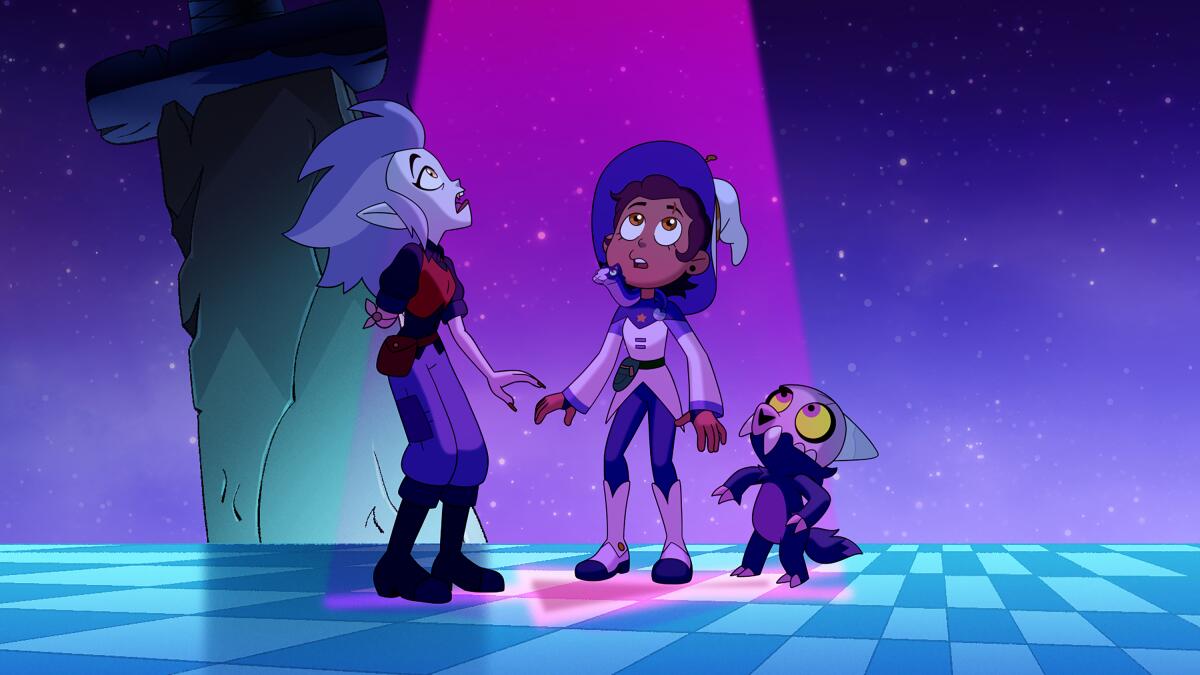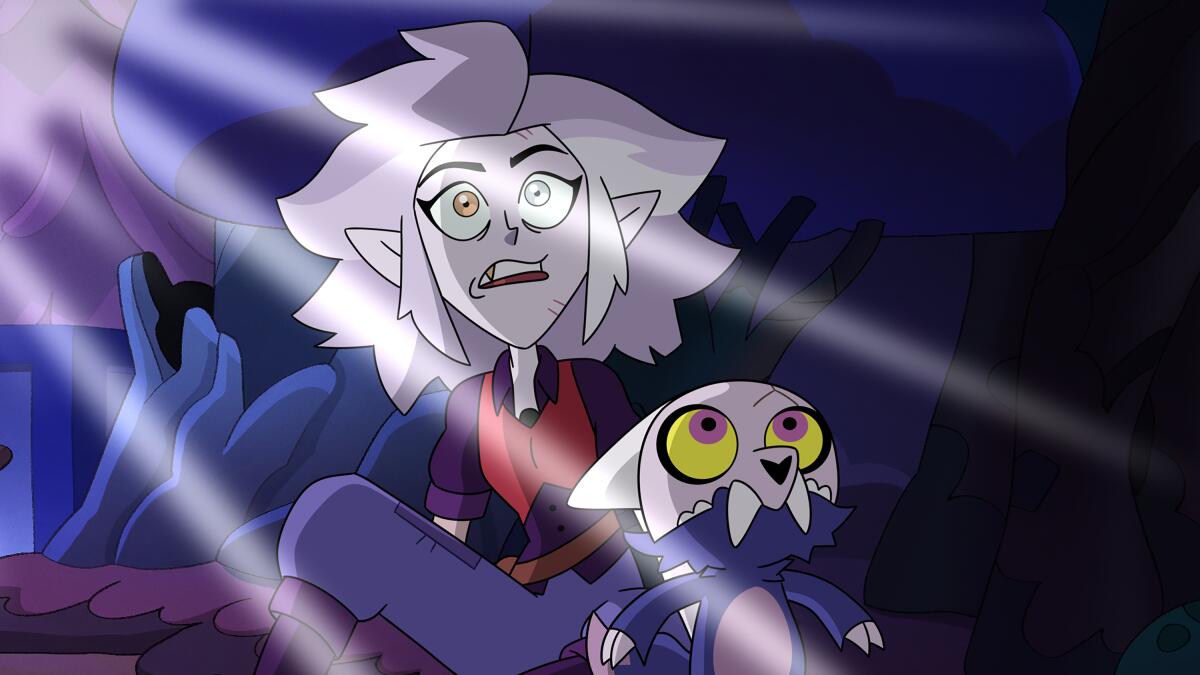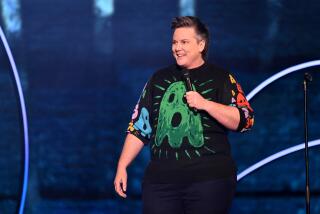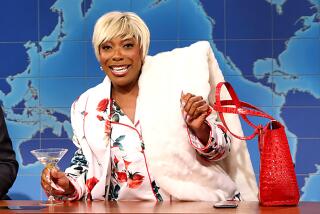Commentary: Queer TV shows are disappearing fast — just when we need them more than ever

From the very first episode of “The Owl House,” its central message has been clear: Embrace your inner weirdo.
“Us weirdos have to stick together,” protagonist Luz Noceda says in the series premiere, rallying a group of oddball strangers to revolt against their unjust imprisonment. “And nobody should be punished for who they are.”
This declaration became increasingly resonant over the course of “The Owl House’s” three-season run, which concluded Saturday, as the show repeatedly broke new ground for LGBTQ representation in kid-friendly animation. Nurturing a central queer teen romance in a world that embraces a full spectrum of sexual orientations and gender identities, the series has been a vital beacon of queer perseverance and joy at a time when right-wing activists and politicians have become increasingly hostile to the LGBTQ community, often targeting queer and trans youth.
In ‘The Super Mario Bros. Movie,’ the elusive Peach has more personality than ever — and wins over a gamer who’d avoided the character all her life.
Created by Dana Terrace, “The Owl House,” which is now available in its entirety on Disney+, follows Luz, a human teenager who stumbles into an alternate dimension known as the demon realm. A spunky, spirited fantasy lover with a penchant for getting carried away, Luz doesn’t quite fit in in the human world, so she decides to begin training as a witch rather than go back home.
No less an outsider in the demon realm — she’s still human, after all — Luz finds her place among fellow misfits like her mentor, Eda, a rebellious witch who refuses to conform, and the tiny but mighty beast King. Her circle of confidants grows to include classmates from her magic school, including frenemy-turned-crush Amity, who Luz eventually starts dating. (For all the reasons Luz had been made to feel like an outsider in either world, being bi was not one of them.)

In the series finale, Luz and her fellow weirdos overcome the odds to triumph over a powerful, manipulative man whose fear and self-righteous ambition have fueled his mission to annihilate everything he refuses to understand. And they save the demon realm without compromising who they are or what they believe in. This is not the time for subtlety.
“The Owl House” debuted in 2020, at a time when LGBTQ visibility on TV was on an upswing. Thanks to the behind-the-scenes efforts of queer creators on shows such as Cartoon Network’s “Steven Universe” and Netflix’s “She-Ra and the Princesses of Power,” queer characters were increasingly front and center and thriving on screen, even in kid-friendly animation. And though Disney had long been criticized as behind the curve compared with other studios and platforms when it came to LGBTQ representation — the company’s own employees pointed to this track record when calling out the company’s lackluster initial response to Florida’s so-called “Don’t Say Gay” bill last year — “The Owl House” raised the bar.
Besides featuring Disney’s first bisexual protagonist, the show set a number of queer precedents with its inclusion of a central queer romance, same-sex kisses, nonbinary characters and more. That the representation is unambiguous and casual — these LGBTQ characters just exist and their identities are not a big deal — makes it that much more meaningful. “The Owl House” was even awarded a Peabody in 2021 “for building a wildly inventive other world that makes room for everyone and giving queer kids a welcome template alongside which to explore their own budding creative energies.”
A former colleague discouraged Dana Terrace from working on her new Disney animated series, “The Owl House.” It’s already been renewed for a second season.
Of course, “The Owl House” is more than a collection of representational milestones. It’s a fun, funny and heartfelt series that celebrates individuality, family, kindness and creativity set in a creepy, vibrant world. But its legacy as such an unabashedly queer show is one of the primary reasons the show concluding after an especially short third season stings.
When “The Owl House” premiered, there were other ongoing shows that were also unapologetically queer, such as the aforementioned “Steven Universe” and “She-Ra,” with some titles still on the way, like Netflix’s “Dead End: Paranormal Park.” It seemed like television was finally catching up to reflect the real world, where mainstream acceptance of LGBTQ people is the norm and marriage equality is a recognized right. Kids were getting to see shows that I wish I had growing up.
Times have quickly changed. Like “The Owl House,” most of the other standout LGBTQ-centric animated shows have concluded or have been canceled. States have passed or proposed an increasing number of anti-LGBTQ laws, including those that prevent any mention of sexual orientation and gender identity in classrooms, ban gender-affirming care, bar students from competing in sports or using restrooms that align with their gender identity, force teachers to out trans students and more. Not to mention the intensifying movement to ban books, including those that even hint at LGBTQ subject matter.

It’s almost as if conservative politicians and activists believe they can legislate us out of existence. In the process , the rollback has emboldened people to be more vocal in their homophobic and transphobic rhetoric. Queer and trans kids deserve better than that.
And while studies have shown that television has been much more inclusive of LGBTQ characters and storylines in recent years, according to GLAAD’s latest “Where We Are on TV” report, overall LGBTQ representation was slightly down during the 2021-2022 television season. The study also noted that more than 20% of LGBTQ characters counted in the study would not be returning next year because their series had concluded or were canceled.
This decline is not surprising. The current media climate, in which companies are scrambling to make their streaming services profitable, has resulted in more shows getting canceled, and some being removed from their platforms altogether. Also not surprising: Many of the shows affected are those trying to tell diverse, inclusive stories. So while other LGBTQ-inclusive animated shows still exist, from Apple TV+’s “Pinecone and Pony” to Disney’s “The Proud Family: Louder and Prouder,” nothing seems poised to fill the void “The Owl House” leaves behind.
But we need shows like “The Owl House” now more than ever. Television alone cannot make the world a better place, especially for the young people directly affected by the right-wing crusade against the queer and trans community. But these young audiences are the ones that most need to see that their stories matter. And they should be able to see themselves as the heroes in these stories without having to compromise who they are.
“The Owl House” helped its audience feel seen and told them that “nobody should be punished for who they are.” It’s time the rest of the world listens.
More to Read
The complete guide to home viewing
Get Screen Gab for everything about the TV shows and streaming movies everyone’s talking about.
You may occasionally receive promotional content from the Los Angeles Times.








